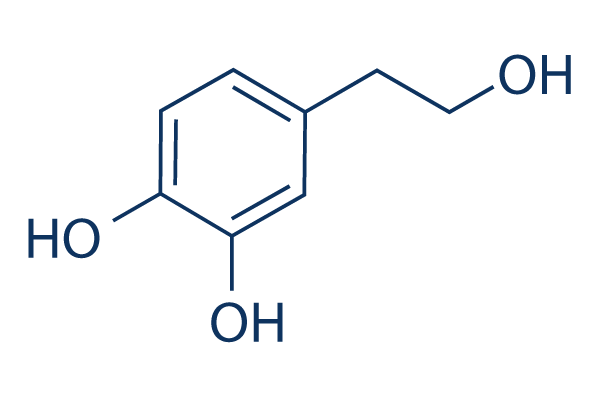|
受注:045-509-1970 |
技術サポート:tech@selleck.co.jp 平日9:00〜18:00 1営業日以内にご連絡を差し上げます |
化学情報

|
Synonyms | 3-Hydroxytyrosol; 3,4-dihydroxyphenylethanol; Dihydroxyphenylethanol; 2-(3,4-Di-hydroxyphenyl)-ethanol | Storage (From the date of receipt) |
3 years -20°C powder 1 years -80°C in solvent |
|||
| 化学式 | C8H10O3 |
||||||
| 分子量 | 154.16 | CAS No. | 10597-60-1 | ||||
| Solubility (25°C)* | 体外 | DMSO | 31 mg/mL (201.08 mM) | ||||
| Water | 31 mg/mL (201.08 mM) | ||||||
| Ethanol | 31 mg/mL (201.08 mM) | ||||||
| 体内 (毎回新しく調製した物を用意してください) |
|
||||||
|
* <1 mg/ml means slightly soluble or insoluble. * Please note that Selleck tests the solubility of all compounds in-house, and the actual solubility may differ slightly from published values. This is normal and is due to slight batch-to-batch variations. |
|||||||
溶剤液(一定の濃度)を調合する
生物活性
| 製品説明 | Hydroxytyrosol (3,4-dihydroxyphenylethanol) is one of the main phenolic components of olive oil with excellent antioxidant, antimicrobial and anticarcinogenic activities. |
|---|---|
| in vitro | Hydroxytyrosol decreases the intracellular reactive oxygen species (ROS) level in MCF10A cells but not in MCF7 or MDA-MB-231 cells. This compound prevents oxidative DNA damage in the three breast cell lines: MCF10A, MDA-MB-231 and MCF7 cells. It is a potent antioxidant because of its marked antioxidant activity, its ability to scavenge oxygen and nitrogen free radicals, to inhibit Low Density Lipoprotein (LDL) oxidation, platelet aggregation and endothelial cell activation and its protection against DNA damage. It is able to reduce the synthesis of prostaglandin E2 blocking the transcription of COX-2 and 5-lipooxygenase, thereby reducing the chronic influence associated with diseases such as cancer[1]. |
| in vivo | HT administration protects against hepatic I/R injury, as indicated by the decreased levels of serum aminotransferase and less parenchymal necrosis and apoptosis. Serum levels of tumor necrosis factor-α, interleukin-6, macrophage inflammatory protein 2, as well as reactive oxygen species (ROS) content in liver tissues, are all decreased by this compound[2]. |
プロトコル(参考用のみ)
| 細胞アッセイ | 細胞株 | MDA-MB-231, MCF10A and MCF7 cells |
|---|---|---|
| 濃度 | 1 to 100 μM | |
| 反応時間 | 24 hours | |
| 実験の流れ | Cells are seeded at 2 × 103 cells/well (MCF7) or 1 × 103 cells/well (MDA-MB-231 and MCF10A) into 96-well culture plates (flat bottom) (100 μL of cell suspension/well). At 24 h after plating, 100 μL of fresh culture medium, with different concentrations of HT is added in triplicate to the wells. Plates are incubated for 24 h or 24 h followed by a 48 h proliferation period with fresh medium at 37 °C and 5% CO2. At these time points, medium is removed and 200 μL of fresh RPMI medium without phenol red that contained XTT (200 μg/mL) and PMS (20 μg/mL) is added. Plates are incubated for 3 h at 37 °C in 5% CO2 and absorbance is measured at 450 nm wavelength (620 nm as reference) in a plate reader. | |
| 動物実験 | 動物モデル | A mouse model of partial hepatic I/R injury (Male BALB/c mice) |
| 投薬量 | 1 or 10 mg/kg | |
| 投与方法 | i.p. |
参考
|
Selleckの高級品が、幾つかの出版された研究調査結果(以下を含む)で使われた:
| Hydroxytyrosol induced ferroptosis through Nrf2 signaling pathway in colorectal cancer cells [ Sci Rep, 2025, 15(1):21271] | PubMed: 40594119 |
| The SAR analysis of dietary polyphenols and their antagonistic effects on bortezomib at physiological concentrations [ Front Pharmacol, 2024, 15:1403424] | PubMed: 39119616 |
| Hydroxytyrosol Recovers SARS-CoV-2-PLpro-Dependent Impairment of Interferon Related Genes in Polarized Human Airway, Intestinal and Liver Epithelial Cells [ Antioxidants (Basel), 2022, 11(8)1466] | PubMed: 36009185 |
| Combination Treatment with Hydroxytyrosol and Vitamin E Improves NAFLD-Related Fibrosis [ Nutrients, 2022, 14(18)3791] | PubMed: 36145170 |
長期の保管のために-20°Cの下で製品を保ってください。
人間や獣医の診断であるか治療的な使用のためにでない。
各々の製品のための特定の保管と取扱い情報は、製品データシートの上で示されます。大部分のSelleck製品は、推薦された状況の下で安定です。製品は、推薦された保管温度と異なる温度で、時々出荷されます。長期の保管のために必要とされてそれと異なる温度で、多くの製品は、短期もので安定です。品質を維持するが、夜通しの積荷のために最も経済的な貯蔵状況を用いてあなたの送料を保存する状況の下に、製品が出荷されることを、我々は確実とします。製品の受領と同時に、製品データシートの上で貯蔵推薦に従ってください。
